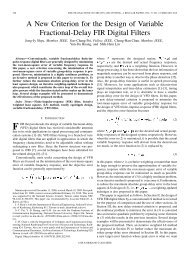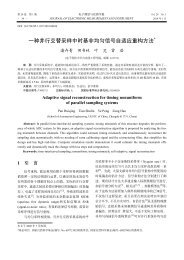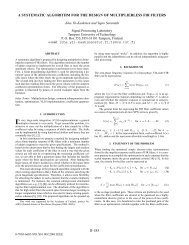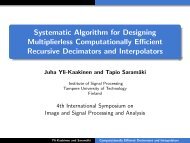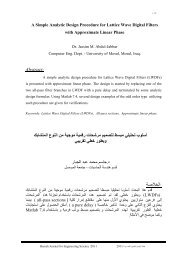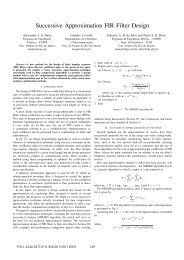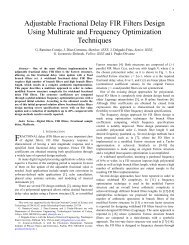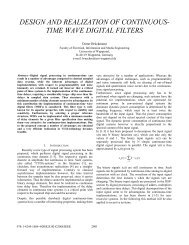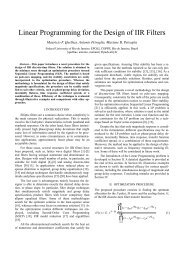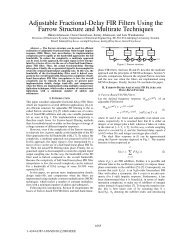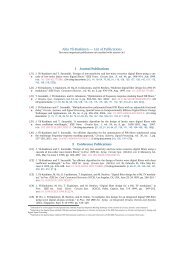A Weighted Least Squares Approach to the Design of ... - IEEE Xplore
A Weighted Least Squares Approach to the Design of ... - IEEE Xplore
A Weighted Least Squares Approach to the Design of ... - IEEE Xplore
Create successful ePaper yourself
Turn your PDF publications into a flip-book with our unique Google optimized e-Paper software.
<strong>IEEE</strong> TRANSACTIONS ON CIRCUITS AND SYSTEMS—II: EXPRESS BRIEFS, VOL. 53, NO. 5, May 2006 379<br />
A <strong>Weighted</strong> <strong>Least</strong> <strong>Squares</strong> <strong>Approach</strong> <strong>to</strong> <strong>the</strong> <strong>Design</strong><br />
<strong>of</strong> FIR Filters Syn<strong>the</strong>sized Using <strong>the</strong> Modified<br />
Frequency Response Masking Structure<br />
W. R. Lee, L. Caccetta, K. L. Teo, Senior Member, <strong>IEEE</strong>, and V. Rehbock<br />
Abstract—This paper presents an application <strong>of</strong> <strong>the</strong> weighted<br />
least squares (WLS) method <strong>to</strong> <strong>the</strong> design <strong>of</strong> sharp linear phase<br />
finite-impulse response (FIR) digital filters syn<strong>the</strong>sized using a<br />
modified frequency-response masking (FRM) structure. In our<br />
approach, <strong>the</strong> original minimax design problem is converted in<strong>to</strong> a<br />
WLS problem. The WLS problem is highly nonlinear with respect<br />
<strong>to</strong> <strong>the</strong> coefficients <strong>of</strong> <strong>the</strong> filter. However, it can be decomposed<br />
in<strong>to</strong> four linear least squares (LS) problems, each <strong>of</strong> which can be<br />
solved analytically. The design problem is <strong>the</strong>n solved iteratively<br />
by using an alternating variable approach. The effectiveness <strong>of</strong> <strong>the</strong><br />
method is demonstrated through solving a low-pass linear phase<br />
sharp FIR digital filter example.<br />
Index Terms—Frequency-response masking (FRM), minimax<br />
error, weighted least squares (WLS), alternating variable approach.<br />
I. INTRODUCTION<br />
THE frequency-response masking approach is one <strong>of</strong> <strong>the</strong><br />
most efficient techniques <strong>to</strong> syn<strong>the</strong>size linear-phase finiteimpulse<br />
response (FIR) digital filters with sharp transition bands<br />
[1]–[4]. This approach produces filters with very sparse coefficients<br />
and hence reduces <strong>the</strong> number <strong>of</strong> multipliers and adders<br />
required when compared with those produced by conventional<br />
direct design methods. The basic structure <strong>of</strong> a filter syn<strong>the</strong>sized<br />
using <strong>the</strong> frequency-response masking (FRM) technique<br />
is shown in Fig. 1. If is <strong>the</strong> -transform transfer function<br />
<strong>of</strong> <strong>the</strong> system, <strong>the</strong>n, from Fig. 1<br />
Here, is <strong>the</strong> interpolated band-edge shaping filter,<br />
which can be obtained by replacing each delay element <strong>of</strong> a<br />
pro<strong>to</strong>type filter, ,by delay elements. is <strong>the</strong> filter<br />
length <strong>of</strong> . and are two masking filters.<br />
Let and be <strong>the</strong> band edges <strong>of</strong> . Then, <strong>the</strong> transition<br />
width <strong>of</strong> is , which increases with .<br />
Hence, <strong>the</strong> complexity <strong>of</strong> decreases with increasing<br />
Manuscript received May 11, 2004. This work was supported by <strong>the</strong> Western<br />
Australian Center <strong>of</strong> Excellence in Industrial Optimization. The work <strong>of</strong> K. L.<br />
Teo was supported by <strong>the</strong> Center for Multimedia Signal Processing <strong>of</strong> <strong>the</strong> Department<br />
<strong>of</strong> Electronics and Information Technology, The Hong Kong Polytechnic<br />
University Hung Hom, Kowloon, Hong Kong, and by <strong>the</strong> Research<br />
Grant Council <strong>of</strong> Hong Kong under Grant Ployu5247/04E. This paper was recommended<br />
by Associate Edi<strong>to</strong>r Y. Lian.<br />
The authors are with <strong>the</strong> Western Australian Centre <strong>of</strong> Excellence in Industrial<br />
Optimization, Department <strong>of</strong> Ma<strong>the</strong>matics & Statistics, Curtin University<br />
<strong>of</strong> Technology, Perth 6845, Australia.<br />
Digital Object Identifier 10.1109/TCSII.2005.862282<br />
Fig. 1.<br />
Basic structure used in <strong>the</strong> FRM technique.<br />
. However, <strong>the</strong> sum <strong>of</strong> <strong>the</strong> transition widths <strong>of</strong> and<br />
is , which is decreasing when increases. If<br />
is very large, both and become sharp filters.<br />
Recently, several modified FRM structures, such as those<br />
reported in [5]–[16] have been introduced. In particular, <strong>the</strong><br />
approach proposed in [12] is <strong>to</strong> replace <strong>the</strong> band-edge shaping<br />
filter with an interpolated FIR (IFIR) filter (for a<br />
definition, see [17]–[19]) so as <strong>to</strong> form an IFIR-FRM structure.<br />
With this new structure, <strong>the</strong> requirements on <strong>the</strong> masking filters<br />
are relaxed. However, <strong>the</strong> drawback <strong>of</strong> this approach is that <strong>the</strong><br />
filter length <strong>of</strong> one <strong>of</strong> <strong>the</strong> masking filters becomes excessively<br />
long, which is not optimal from a structural point <strong>of</strong> view. This<br />
is because minimum complexity is achieved (see [2], [20]) only<br />
when <strong>the</strong> transition widths (or complexity) <strong>of</strong> <strong>the</strong> two masking<br />
filters are equal. To address this problem, <strong>the</strong> IFIR-FRM structure<br />
proposed in [12] is fur<strong>the</strong>r improved in [11]. First, <strong>the</strong><br />
IFIR-based band-edge shaping filter is generalized <strong>to</strong> an IFIR<br />
alike filter. Secondly, an additional filtering stage is inserted<br />
between <strong>the</strong> band-edge shaping filter and <strong>the</strong> masking filters so<br />
as <strong>to</strong> decouple <strong>the</strong> masking filters from <strong>the</strong> band-edge shaping<br />
filter. Hence, <strong>the</strong> complexity <strong>of</strong> <strong>the</strong> overall filter is reduced significantly.<br />
However, it is noted that <strong>the</strong> subfilters are essentially<br />
optimized separately in <strong>the</strong>se papers.<br />
This paper introduces a joint optimization method for <strong>the</strong><br />
design <strong>of</strong> linear-phase FIR digital filters syn<strong>the</strong>sized using<br />
<strong>the</strong> modified FRM structure introduced in [11]. The method<br />
is based on <strong>the</strong> weighted least squares (WLS) approach. The<br />
original least squares (LS) problem is decomposed in<strong>to</strong> four<br />
simple linear LS problems. Each <strong>of</strong> <strong>the</strong>se linear LS problems<br />
can be solved analytically. The WLS problem is <strong>the</strong>n solved<br />
iteratively by alternately solving each <strong>of</strong> <strong>the</strong>se four linear LS<br />
problems with appropriately updated weighting functions.<br />
II. PROBLEM<br />
The modified structure <strong>of</strong> an FIR filter syn<strong>the</strong>sized using <strong>the</strong><br />
FRM technique, introduced in [11], is shown in Fig. 2. If<br />
1057-7130/$20.00 © 2006 <strong>IEEE</strong>
380 <strong>IEEE</strong> TRANSACTIONS ON CIRCUITS AND SYSTEMS—II: EXPRESS BRIEFS, VOL. 53, NO. 5, May 2006<br />
Fig. 2.<br />
The Modified FRM structure.<br />
in Fig. 3(d). The transition width <strong>of</strong> is narrower than<br />
that <strong>of</strong> by a fac<strong>to</strong>r <strong>of</strong> . With this new structure, <strong>the</strong><br />
restriction on <strong>to</strong> be a multiple <strong>of</strong> , which is required<br />
for an IFIR-FRM approach [12], is relaxed. Fur<strong>the</strong>rmore, an<br />
additional decoupling filter is inserted <strong>to</strong> balance <strong>the</strong><br />
complexities <strong>of</strong> <strong>the</strong> two masking filters. The requirement on<br />
<strong>the</strong> masking filters and is, <strong>the</strong>refore, fur<strong>the</strong>r<br />
relaxed (For details, see [11]).<br />
Given <strong>the</strong> passband edge , <strong>the</strong> s<strong>to</strong>pband edge , <strong>the</strong><br />
permitted maximum passband ripple , and <strong>the</strong> s<strong>to</strong>pband<br />
ripple <strong>of</strong> a desired filter, <strong>the</strong> interpolation ratios ,<br />
and for <strong>the</strong> subfilters , , and , respectively, can<br />
be optimized (for details, see [11]). The band edges for <strong>the</strong><br />
subfilters and can be derived using <strong>the</strong><br />
equations in [1], [11], [20]. Therefore, <strong>the</strong> general problem <strong>of</strong><br />
designing an FIR filter syn<strong>the</strong>sized using <strong>the</strong> modified FRM<br />
structure introduced in [11] may be formulated as: Given <strong>the</strong><br />
band edges and <strong>the</strong> permitted maximum band ripples<br />
and , and <strong>the</strong> interpolation ratios and , find,<br />
respectively, <strong>the</strong> filter lengths and <strong>of</strong> <strong>the</strong><br />
subfilters <strong>of</strong> <strong>the</strong> system, and coefficients<br />
and<br />
<strong>of</strong> <strong>the</strong> subfilters and , such that <strong>the</strong><br />
maximum error, , is minimized over <strong>the</strong> whole region,<br />
where is defined by<br />
Fig. 3. Frequency responses <strong>of</strong> (a) F (z ) and F (z ); (b) F (z ); (c)<br />
F (z) and F (z); (d) F (z).<br />
is <strong>the</strong><br />
Fig. 2<br />
where<br />
-transform transfer function <strong>of</strong> <strong>the</strong> system, <strong>the</strong>n, from<br />
Here, and are <strong>the</strong> frequency weighting function<br />
and <strong>the</strong> desired response <strong>of</strong> <strong>the</strong> system, respectively. In <strong>the</strong> passband,<br />
and are equal <strong>to</strong> one. In <strong>the</strong> s<strong>to</strong>pband,<br />
is equal <strong>to</strong> and is equal <strong>to</strong> zero.<br />
This minimax problem is <strong>to</strong> be solved as a WLS problem.<br />
More specifically, we minimize <strong>the</strong> objective function<br />
(1)<br />
(2)<br />
where is a dense set <strong>of</strong> frequencies uniformly distributed in<br />
, and is a weighting function. Let this<br />
WLS problem be referred <strong>to</strong> as Problem .<br />
The frequency response magnitudes<br />
and ,<br />
<strong>of</strong> <strong>the</strong>se filters are shown in Fig. 3. If<br />
and<br />
have <strong>the</strong> same phase delay, <strong>the</strong> resulting<br />
frequency response magnitude, ,<strong>of</strong> is shown<br />
III. SOLUTION METHOD<br />
Suppose that <strong>the</strong> filter lengths<br />
, <strong>of</strong> <strong>the</strong> subfilters<br />
are determined. Then, Problem reduces <strong>to</strong> finding<br />
<strong>the</strong> coefficients and <strong>of</strong> <strong>the</strong> subfilters<br />
and , respectively, such that <strong>the</strong> objective<br />
function (2) is minimized. The objective function is highly<br />
nonlinear with respect <strong>to</strong> <strong>the</strong> coefficients <strong>of</strong> <strong>the</strong> subfilters. Thus,<br />
it is very difficult <strong>to</strong> minimize <strong>the</strong> objective function using any<br />
direct optimization approach. In [21], an unconstrained WLS<br />
algorithm is used <strong>to</strong> jointly optimize <strong>the</strong> subfilters <strong>of</strong> an FIR<br />
filter syn<strong>the</strong>sized using <strong>the</strong> original one-stage FRM structure.<br />
In each step, a quasi-New<strong>to</strong>n method is employed, where <strong>the</strong><br />
Davidon–Fletcher–Powell (DFP) formula is used <strong>to</strong> update <strong>the</strong><br />
search direction. The objective function is highly nonlinear<br />
and nonconvex with respect <strong>to</strong> <strong>the</strong> coefficients. Fur<strong>the</strong>rmore,<br />
its Hessian matrix is dense. Thus, <strong>the</strong> method can be computationally<br />
expensive for large problems. The optimization<br />
problem addressed in [21] is for <strong>the</strong> one-stage FRM structure.
LEE et al.: WLS APPROACH TO DESIGN OF FIR FILTERS 381<br />
In contrast, <strong>the</strong> optimization problem described in this paper<br />
is for <strong>the</strong> modified FRM structure, where <strong>the</strong> single band-edge<br />
shaping filter in <strong>the</strong> one-stage FRM structure is replaced by a<br />
cascade combination <strong>of</strong> three subfilters. Clearly, <strong>the</strong> optimization<br />
problem addressed in this paper is much more complicated<br />
than that considered in [21]. Therefore, <strong>the</strong> direct optimization<br />
method proposed in [21] is unlikely <strong>to</strong> work for this problem.<br />
By careful examination <strong>of</strong> Problem , we see that it can<br />
be conveniently decomposed in<strong>to</strong> several subproblems, as<br />
certain subsets <strong>of</strong><br />
affect fairly distinct<br />
parts <strong>of</strong> <strong>the</strong> frequency range [1]. In <strong>the</strong> part <strong>of</strong> <strong>the</strong> frequency<br />
range where and are both equal <strong>to</strong> 1 or 0, <strong>the</strong> error<br />
is determined mainly by and , while <strong>the</strong> effect <strong>of</strong><br />
is <strong>of</strong> secondary importance. On <strong>the</strong> o<strong>the</strong>r hand, in<br />
<strong>the</strong> frequency range where<br />
is large, (i.e.,<br />
when or ), <strong>the</strong> error is very much determined<br />
by . We thus divide in<strong>to</strong><br />
two subsets, and . The influence <strong>of</strong><br />
each subset is largely restricted <strong>to</strong> <strong>the</strong> corresponding parts <strong>of</strong><br />
<strong>the</strong> frequency range. Their effects are mutually compensated<br />
only on relatively small intervals <strong>of</strong> <strong>the</strong> frequency range. We<br />
<strong>the</strong>refore propose an alternating variable approach based on<br />
<strong>the</strong>se two groups <strong>of</strong> coefficients <strong>to</strong> solve Problem . For this,<br />
let us first define <strong>the</strong> following two optimization subproblems.<br />
Problem : The coefficients and <strong>of</strong> <strong>the</strong> objective<br />
function (2) are taken as fixed. Let <strong>the</strong> corresponding new<br />
objective function be denoted as ,<br />
where is <strong>the</strong> weighting function which is <strong>to</strong> be appropriately<br />
updated.<br />
Problem : The coefficients and <strong>of</strong> <strong>the</strong> objective<br />
function (2) are taken as fixed. Let <strong>the</strong> corresponding new<br />
objective function be denoted as<br />
where is <strong>the</strong> weighting function which is <strong>to</strong> be appropriately<br />
updated.<br />
Problem : is solved through solving Problem and<br />
Problem alternately. Problems and are solved as<br />
follows.<br />
Note that Problem contains two unknown sets <strong>of</strong> coefficients<br />
and . These belong <strong>to</strong> <strong>the</strong> subfilters and<br />
, respectively, which are connected in parallel. As a result,<br />
<strong>the</strong> frequency response magnitude <strong>of</strong> <strong>the</strong> overall filter is<br />
linear with respect <strong>to</strong> <strong>the</strong> coefficients in and . Therefore,<br />
Problem can be solved analytically (details are given<br />
in Section III-A). Problem contains three unknown sets<br />
<strong>of</strong> coefficients, and belonging <strong>to</strong> <strong>the</strong> subfilters,<br />
and , respectively. These subfilters are connected in a cascade<br />
fashion. Thus, <strong>the</strong> frequency response magnitude <strong>of</strong> <strong>the</strong> overall<br />
filter is nonlinear with respect <strong>to</strong> <strong>the</strong> coefficients,<br />
and . To overcome <strong>the</strong> complexity in <strong>the</strong> minimization on <strong>the</strong><br />
objective function (2) with respect <strong>to</strong> <strong>the</strong> coefficients, and<br />
, we decompose Problem fur<strong>the</strong>r in<strong>to</strong> three subproblems<br />
and <strong>the</strong>n use an alternating variable method <strong>to</strong> solve it. Let us<br />
define <strong>the</strong> following three optimization subproblems.<br />
Problem : The coefficients and<br />
<strong>of</strong> <strong>the</strong> objective function (2) are taken as fixed. Let<br />
<strong>the</strong> corresponding new objective function be denoted as<br />
, where is <strong>the</strong> weighting function<br />
which is <strong>to</strong> be appropriately updated.<br />
Problem : The coefficients and<br />
<strong>of</strong> <strong>the</strong> objective function (2) are taken as fixed. Let<br />
<strong>the</strong> corresponding new objective function be denoted as<br />
, where is <strong>the</strong> weighting function<br />
which is <strong>to</strong> be appropriately updated.<br />
Problem : The coefficients and<br />
<strong>of</strong> <strong>the</strong> objective function (2) are taken as fixed. Let<br />
<strong>the</strong> corresponding new objective function be denoted as<br />
, where is <strong>the</strong> weighting function<br />
which is <strong>to</strong> be appropriately updated.<br />
Problem is <strong>the</strong>n solved through solving a sequence <strong>of</strong><br />
Problems and alternately.<br />
There are now two instances <strong>of</strong> an alternating variable search.<br />
The first one is <strong>to</strong> solve Problem via Problems and<br />
. The second one is <strong>to</strong> solve Problem via Problems<br />
and . However, this approach is computationally<br />
time-consuming. Thus, we propose ano<strong>the</strong>r technique,<br />
where <strong>the</strong> alternating search within Problem is incorporated<br />
in<strong>to</strong> <strong>the</strong> alternating search between Problems and<br />
. It may be described as follows:<br />
Data: Choose a positive integer , and a small positive real<br />
number .<br />
Step 1) Find an initial filter<br />
(without ) by designing <strong>the</strong> subfilters,<br />
and separately.<br />
Set <strong>the</strong> initial weighting function, , and<br />
iteration number, . Set and .<br />
Step 2) Minimize with respect<br />
<strong>to</strong> <strong>the</strong> coefficients . Denote <strong>the</strong> optimal<br />
coefficients obtained as .<br />
Step 3) Minimize with respect<br />
<strong>to</strong> <strong>the</strong> coefficients and . Denote <strong>the</strong><br />
optimal coefficients obtained as and .If<br />
, go<strong>to</strong> Step 4. If , go<strong>to</strong> Step 5. If ,<br />
set .If , go<strong>to</strong> Step 6. O<strong>the</strong>rwise, set<br />
and go<strong>to</strong> Step 2).<br />
Step 4) Minimize with respect<br />
<strong>to</strong> <strong>the</strong> coefficients . Denote <strong>the</strong> optimal<br />
coefficients obtained as . Set . Go<strong>to</strong> Step<br />
3).<br />
Step 5) Minimize with respect<br />
<strong>to</strong> <strong>the</strong> coefficients . Denote <strong>the</strong> optimal<br />
coefficients obtained as . Set and go<strong>to</strong><br />
Step 3).<br />
Step 6) Calculate<br />
.If , where is a prescribed<br />
<strong>to</strong>lerance, <strong>the</strong>n s<strong>to</strong>p. O<strong>the</strong>rwise, update<br />
, where is defined in <strong>the</strong> next<br />
section. Set<br />
and go <strong>to</strong><br />
Step 2).<br />
From our extensive numerical simulation study, we observe<br />
that for <strong>the</strong> filter design using <strong>the</strong> above procedure, <strong>the</strong> filter<br />
lengths <strong>of</strong> <strong>the</strong> subfilters and<br />
are estimated <strong>to</strong> be approximately 100, 100, 85, 65 and 65<br />
percent, respectively, <strong>of</strong> those designs obtained by <strong>the</strong> technique<br />
in [11].
382 <strong>IEEE</strong> TRANSACTIONS ON CIRCUITS AND SYSTEMS—II: EXPRESS BRIEFS, VOL. 53, NO. 5, May 2006<br />
Remark: In Step 6) <strong>of</strong> <strong>the</strong> algorithm, <strong>the</strong> weighting function<br />
is updated every iterations. From our extensive numerical<br />
simulation experience, we observe that it is sufficient <strong>to</strong> choose<br />
<strong>to</strong> be between 3 and 5. The <strong>to</strong>lerance determines <strong>the</strong> terminating<br />
condition for <strong>the</strong> algorithm.<br />
A. Solution <strong>of</strong> Problem<br />
Note that <strong>the</strong> optimality condition for <strong>the</strong> coefficients<br />
and <strong>of</strong> Problem is easily obtained by setting <strong>the</strong> gradient<br />
<strong>of</strong> <strong>the</strong> objective function with respect <strong>to</strong> <strong>the</strong>se coefficients<br />
<strong>to</strong> zero. This gives rise <strong>to</strong> <strong>the</strong> following system <strong>of</strong> linear<br />
equations:<br />
where<br />
.<br />
.<br />
where and are appropriate trigonometric<br />
functions for subfilters and , respectively,<br />
and<br />
(3)<br />
(4)<br />
The least-squares solution <strong>of</strong> (9) is given by<br />
(13)<br />
For Problem<br />
, where<br />
are appropriate trigonometric functions for subfilter ,<br />
, and<br />
. For Problem<br />
,<br />
where are appropriate trigonometric<br />
functions for subfilter , and<br />
.<br />
For Problem<br />
, where are appropriate<br />
trigonometric functions for subfilter<br />
, and<br />
.<br />
The updated error weighting function at each iteration is<br />
given [22] by<br />
with<br />
In order <strong>to</strong> prevent from getting <strong>to</strong>o close <strong>to</strong> zero, we<br />
introduce a lower bound, , similar <strong>to</strong> <strong>the</strong> one used in [22]<br />
is <strong>the</strong> weighting matrix given by<br />
(5)<br />
(6)<br />
where<br />
To accelerate <strong>the</strong> convergence, is made proportional <strong>to</strong><br />
a higher power <strong>of</strong> as given by [22]<br />
and<br />
. ..<br />
(7)<br />
is a dense set <strong>of</strong> frequencies uniformly distributed in<br />
. The least-squares solution <strong>of</strong> (3) is given by<br />
B. Solutions <strong>of</strong> Problems and<br />
Note that <strong>the</strong> optimality conditions for Problems<br />
, and are easily obtained by setting <strong>the</strong><br />
gradients <strong>of</strong> <strong>the</strong> objective functions and with<br />
respect <strong>to</strong> <strong>the</strong>ir associated coefficients equal <strong>to</strong> zero. They give<br />
rise <strong>to</strong> <strong>the</strong> following form <strong>of</strong> linear system:<br />
where<br />
and <strong>the</strong> weighting matrix is defined by (7).<br />
.<br />
.<br />
(8)<br />
(9)<br />
. ..<br />
(10)<br />
(11)<br />
(12)<br />
Here, is <strong>the</strong> minimax weighting function as indicated<br />
before, and is a constant which is selected <strong>to</strong> maintain<br />
a reasonable dynamic range for <strong>the</strong> value <strong>of</strong> .Asin<br />
[22], <strong>the</strong> constant may be selected as <strong>the</strong> average value <strong>of</strong><br />
over all . The constant affects <strong>the</strong> rate <strong>of</strong><br />
convergence, see [22] for details. We take <strong>the</strong> value <strong>of</strong> <strong>to</strong> be<br />
between 1 and 1.7 as in [22].<br />
IV. DESIGN EXAMPLE<br />
As in [11] and [12], a linear phase low-pass FIR filter with<br />
<strong>the</strong> passband frequencies<br />
and <strong>the</strong> s<strong>to</strong>pband<br />
frequencies<br />
is considered. The allowable<br />
maximum passband and s<strong>to</strong>pband ripples are<br />
and<br />
, respectively. We use <strong>the</strong> same interpolation<br />
ratios as in [11]: , , and .For<br />
WLS Chebyshev solution, we use 10 001 sample points in <strong>the</strong><br />
frequency range. Our method takes 364 iterations <strong>to</strong> meet <strong>the</strong><br />
minimax criteria with Problems ,<br />
and being solved alternately 4 times at each iteration. All<br />
computations are performed on an SGI Origin 2000. The computer<br />
used 13.1 minutes <strong>to</strong> complete <strong>the</strong> calculation. The filter<br />
lengths <strong>of</strong> , and used are 83, 21, 49, 38,<br />
and 16, respectively. 105 multipliers are needed. The maximum
LEE et al.: WLS APPROACH TO DESIGN OF FIR FILTERS 383<br />
14% savings in <strong>the</strong> number <strong>of</strong> multipliers required when compared<br />
with <strong>the</strong> filter produced in [11]. The frequency response<br />
<strong>of</strong> <strong>the</strong> filter and subfilters designed by <strong>the</strong> proposed method are<br />
depicted in Figs. 4– 6, respectively.<br />
Fig. 4.<br />
Frequency response <strong>of</strong> <strong>the</strong> overall filter.<br />
Fig. 5. Frequency response <strong>of</strong> F (w) and F (w).<br />
Fig. 6. Frequency responses <strong>of</strong> F (M w) (solid line), F (M w) (dashed<br />
line) and F (M w) (doted line).<br />
passband and s<strong>to</strong>pband ripples achieved are<br />
and<br />
, respectively. For comparison, <strong>the</strong> filter<br />
lengths <strong>of</strong> , and used in [11] <strong>to</strong> meet <strong>the</strong> requirements<br />
are 83, 21, 57, 56, 24, respectively. 122 multipliers<br />
are needed. The filter designed by using our approach yields a<br />
REFERENCES<br />
[1] Y. C. Lim, “Frequency-response masking approach for <strong>the</strong> syn<strong>the</strong>sis <strong>of</strong><br />
sharp linear phase digital filter,” <strong>IEEE</strong> Trans. Circuits Syst., vol. CAS-33,<br />
no. 4, pp. 357–364, Apr. 1986.<br />
[2] Y. C. Lim and Y. Lian, “The optimum design <strong>of</strong> one- and two-dimensional<br />
FIR filters using <strong>the</strong> frequency response masking technique,”<br />
<strong>IEEE</strong> Trans. Circuits Syst. II, Analog Digit. Signal Process., vol. 40, no.<br />
2, pp. 88–95, Feb. 1993.<br />
[3] Y. C. Lim and S. H. Low, “Frequency-response masking approach for<br />
<strong>the</strong> syn<strong>the</strong>sis <strong>of</strong> sharp two-dimensional diamond-shaped filters,” <strong>IEEE</strong><br />
Trans. Circuits Syst. II, Analog Digit. Signal Process., vol. 45, no. 12,<br />
pp. 1573–1584, Dec. 1998.<br />
[4] T. Saramäki and Y. C. Lim, “Use <strong>of</strong> <strong>the</strong> Remez algorithm for designing<br />
FRM based FIR filters,” Circuits, Syst. Signal Process., vol. 22, no. 2,<br />
pp. 77–97, Apr. 2003.<br />
[5] M. G. Bellanger, “Improved design <strong>of</strong> long FIR filters using <strong>the</strong> frequency<br />
masking technique,” in Proc. <strong>IEEE</strong> Int. Conf. Acoust., Speech,<br />
Signal Process., Atlanta, GA, May 1996, pp. 1272–1275.<br />
[6] Y. Lian, “A new frequency response masking structure with reduced<br />
complexity for FIR filter design,” in Proc. <strong>IEEE</strong> Int. Symp. Circuits Syst.,<br />
vol. II, Sydney, NSW, Australia, May 2001, pp. 609–612.<br />
[7] , “Reducing <strong>the</strong> complexity <strong>of</strong> <strong>the</strong> masking filter in a frequency-response<br />
masking approach,” in Proc. 3rd Int. Conf. Inf., Commun., Signal<br />
Process., Singapore, Oct. 2001.<br />
[8] , “A modified frequency-response masking structure for high-speed<br />
FPGA implementation <strong>of</strong> sharp FIR filters,” J. Circuits Syst. Comp., vol.<br />
12, no. 5, pp. 643–654, Oct. 2003.<br />
[9] , “Complexity reduction for FRM-based FIR filters using <strong>the</strong> prefilter-equalizer<br />
technique,” Circuits, Syst. Signal Process., vol. 22, no. 2,<br />
pp. 137–155, Apr. 2003.<br />
[10] Y. Lian and Y. C. Lim, “Reducing <strong>the</strong> complexity <strong>of</strong> frequency-response<br />
masking filters using half band filters,” Signal Process., vol. 42, no. 3,<br />
pp. 227–230, Mar. 1995.<br />
[11] Y. Lian and C. Z. Yang, “Complexity reduction by decoupling <strong>the</strong><br />
masking filters from <strong>the</strong> bandedge shaping filter in <strong>the</strong> FRM technique,”<br />
Circuits, Syst. Signal Process., vol. 22, no. 2, pp. 115–135, Apr. 2003.<br />
[12] Y. Lian, L. Zhang, and C. C. Ko, “An improved frequency response<br />
masking approach designing sharp FIR filters,” Signal Proces., vol. 81,<br />
pp. 2573–2581, Dec. 2001.<br />
[13] Y. C. Lim and Y. Lian, “Frequency response masking approach for digital<br />
filter design: Complexity reduction via masking filter fac<strong>to</strong>rization,”<br />
<strong>IEEE</strong> Trans. Circuits Syst. II, Analog Digit. Signal Process., vol. 41, no.<br />
8, pp. 518–525, Aug. 1994.<br />
[14] T. Saramäki and J. Yli-Kaakinen, “Optimization <strong>of</strong> frequency-response<br />
masking based FIR filters with reduced complexity,” in Proc. <strong>IEEE</strong> Int.<br />
Symp. Circuits Syst., vol. III, Phoenix, AZ, May 2002, pp. 225–228.<br />
[15] R. Yang, B. Liu, and Y. C. Lim, “A new structure <strong>of</strong> sharp transition FIR<br />
filters using frequency-response masking,” <strong>IEEE</strong> Trans. Circuits Syst.,<br />
vol. CAS-35, no. 8, pp. 955–966, Aug. 1988.<br />
[16] L. Zhang, Y. Lian, and C. C. Ko, “A new approach for designing sharp<br />
FIR filters using frequency-response masking technique,” Proc. 9th<br />
<strong>IEEE</strong> DSP Workshop, Oct. 2000.<br />
[17] Y. Neuvo, C. Y. Dong, and S. K. Mitra, “Interpolated finite impulse<br />
response filters,” <strong>IEEE</strong> Trans. Acoust. Speech, Signal Process, vol.<br />
ASSP-32, no. 3, pp. 563–570, Jun. 1984.<br />
[18] J. Cabezas and P. Diniz, “FIR filters using interpolated prefilters and<br />
equalizers,” <strong>IEEE</strong> Trans. Circuits Syst., vol. 37, no. 1, pp. 17–23, Jan.<br />
1990.<br />
[19] T. Saramäki, Y. Neuvo, and S. K. Mitra, “<strong>Design</strong> <strong>of</strong> computationally<br />
efficient interpolated FIR filters,” <strong>IEEE</strong> Trans. Circuits Syst., vol. 35,<br />
no. 1, pp. 70–88, Jan. 1988.<br />
[20] T. Saramäki and H. Johansson, “Optimization <strong>of</strong> FIR filters using <strong>the</strong><br />
frequency-response masking approach,” in Proc. <strong>IEEE</strong> Int. Symp. Circuits<br />
Syst., vol. II, Sydney, NSW, Australia, May 2001, pp. 177–180.<br />
[21] Y. J. Yu and Y. C. Lim, “FRM based FIR filter design—The WLS approach,”<br />
in Proc. <strong>IEEE</strong> Int. Symp. Circuits Syst., vol. II, Phoenix, AZ,<br />
May 2002, pp. 221–224.<br />
[22] Y. C. Lim, J. H. Lee, C. K. Chen, and R. H. Yang, “A weighted least<br />
squares algorithm for quasi-equiripple FIR and IIR digital filter design,”<br />
<strong>IEEE</strong> Trans. Signal Proces., vol. 40, no. 3, pp. 551–558, Mar. 1992.



